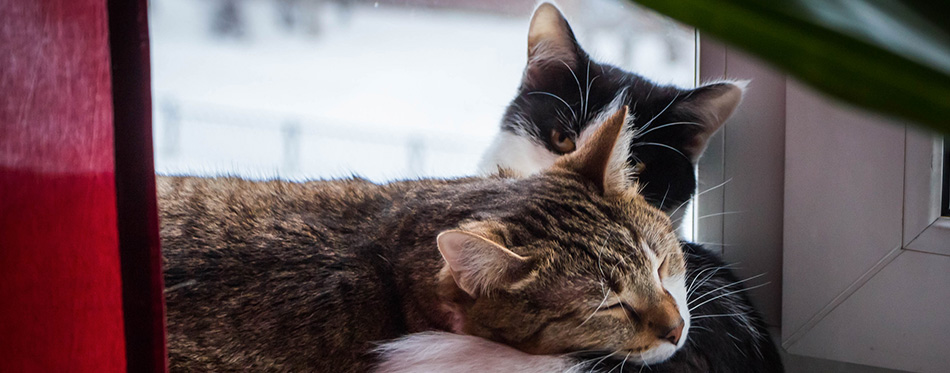Unlike other pets like dogs, it is not easy to differentiate a male and a female cat based on appearances alone. This is especially true among very young kittens where the genital organs are not very obvious. One has to base the differences on the cat’s behavior and correlate this to the pet’s physical characteristic. In this article, we will look at the differences between male and female cats, starting with the kittens.

Sex Differences Among Kittens
If you are adopting a young kitten, there is a good chance that you will not yet know its sex. It should be obvious that the main difference between male and female kittens is their genitalia. Young males should have penis and testicles, while their female brethren should have a vagina.
Unfortunately, you will not be able to see this physical difference until the young cat reaches 6 to 8 weeks old. By that time, you should already be able to identify whether the young feline you adopted is a male or a female.
Determining the gender of young kittens requires a more thorough examination of the animal’s genital area. Among puppies, it is very easy to determine if it is a boy or a girl puppy. Kittens, on the other hand, require adhering to the “punctuation marks” rule. The thing that you have to understand is that the penis and scrotum of young male cats are not normally visible. Many pet parents make the mistake of thinking that their kitties are females because they lack a penis or testes.
In checking the kitten’s sex, you will need to encourage it to raise its tail. Try rubbing or scratching the young kitty’s back. Most cats will raise their tail in an instant if you do this. Once the cat has its tail raised, look at the area below its anus. If what you see is an inverted “exclamation point” – the dot is above the vertical line – then the cat is a female. The “dot” is the animal’s anal opening, while the “slit” or “line” is the pet’s vaginal orifice.
It is also possible to see two “small dots” corresponding to the female cat’s anus (upper dot) and vagina (lower dot). In such cases, it is important to look at the spacing between the two “dots”. There should be no more than half an inch of space separating the two dots. If the space in between the “dots” are wider than half an inch, you may have a male kitty in your hands.
The upper “dot” in males corresponds to its anus while the lower “dot” shows where its penis will be once it grows. The wider space between these two “dots” represents the area where you will find the young kitty’s testicles.
Now you know how to determine the difference between male and female kittens based on their sex organs.
Sex Differences Among Adult Cats
When differentiating between an adult male cat and an adult female kitty, you can always rely on their sex organs. Intact or unneutered adult kitties will have visible scrotum. But if you have a longhaired breed, this may require parting the hairs to get a good look at this body part. If you can see it, then it is a male. However, it is important to point out that neutered cats will not have a visible scrotum. Hence, you will need to look at other things to determine whether you have a female kitty or a male feline.

Physical Characteristics
Did you know that there is a difference between male and female cat faces? Intact males have larger jowls than females and neutered cats. The reason is quite simple. Nature gave unneutered cats a larger jowl to help protect them from injuries during mating and in territorial fights.
Intact tomcats are more prone to fights, either for safeguarding their territory or exerting their dominance for a female cat in heat. When they get into a fight, their opponents will often go for the area on the tomcat’s cheek. With a larger jowl, the intact tomcat can protect itself from more serious injuries.
So, the next time you see a cat, take a look at its jowl. If it is wider than usual, there is a good chance that you have an intact male. If not, then there is a possibility that it is a neutered cat or a female kitty.
In addition to the difference between male and female cat faces, they can also differ in the color of their coat. It is very rare for male kitties to have a black-and-orange tortoiseshell or tri-colored calico coat pattern. If you see these coat patterns, there is a strong likelihood that the cat is a female.
On the other hand, it is rare for female felines to have a ginger- or orange-colored coat. It is also rare for female kitties to have white-and-orange stripes. This does not mean that there are no female cats that have these colors, however. What it only shows is that the majority of female kitties will not have such colors.
When it comes to the size, the notion that males are bigger than females holds true; although the size difference is not as pronounced as what you can see in dogs. There is also the impact of diet on the size of the cat. Given two cats fed with the same amount and type of food, the male will always come out bigger and heavier. It is, therefore, possible to have a female kitty weighing more and looking bigger than its male counterpart.
Aside from these physical differences, there are a few others that can help you differentiate a male from a female kitty.
All cats – both males and females – have nipples. However, the nipples of a cat that has recently given birth will be more obvious than other felines. If you notice vaginal discharge during the mating season, then that is an obvious sign that the animal is a female. If the cat has a distended, low-hanging belly, there is also a good chance that it is a female.
Temperament
In general, female cats are more concerned about caring for their kittens. It is for this reason that many female cats will be less affectionate to their owners than male felines. For them, nothing is more important than raising its family and continuing its lineage. Female cats are loving mothers to their young kittens. They will try to provide the best possible care for them, including the kittens’ security and safety.
Hence, females tend to be more aloof or independent. They may still appreciate cuddling from time to time, but only when done on their terms. If you pick it up and cuddle with it, there is a chance that the female cat will show some form of resistance. This is because it thinks that time spent with you is time spent away from its kittens.
For obvious reasons, spaying the cat can lessen this feline “maternal” instinct. It can allow the female cat to focus its affection to its owner.
On the other hand, male felines are more amiable, affectionate, and loyal to their human owners. They do not have the characteristic “maternal instincts” that will make them focus their energies on their kittens. For these cats, nothing is more precious than the affection that they receive from their owners.
With the free-spirited nature of male kitties, they can be very adorable companions. These are the kind of cats that will jump into your lap and relish the experience of your stroking its fur. It will rub its head when it gets the chance and will let out its sweetest purr.
Mating Behavior
Mating is another area where the differences between feline genders are very evident. Of course, if you have a neutered or spayed feline pet, then these manifestations will be almost imperceptible.
Intact tomcats can be very aggressive once they sense that there are female cats that are in heat. They are more ready to fight, scratch, bite, and hiss. You can also see them increase the frequency of their territorial markings. Intact tomcats will pee on almost any surface that they will find. This behavior is understandable from the point of view of felines. They want to announce to the whole world that they are the boss. And if there are stray tomcats in the area, the markings will serve as a warning.
In like manner, intact female felines can be very vocal. They can make pretty annoying sounds in the night when the world is already sleeping. They will yowl to the point that the entire neighborhood gets awakened.
It is true that there are feline breeds that are very vocal. There are also those that are quiet. However, when the female cat is in heat, expect the quietest felines to start yowling and meowing.
Spaying or neutering your pet feline will address these issues. Unfortunately, you cannot make your neighbors have their pets spayed or neutered as well. The most you can do is to encourage them to do so.

Territoriality
The consensus is that male cats are more territorial than females. This is regardless of whether there is a nearby kitty in heat or not. It will mark the territory that it believes is his. It will defecate and urinate in these areas to make sure that the cat’s scent will be made an integral part of the environment. The same is true when it rubs its body against a structure or object. It is imparting pheromones onto the surfaces of these objects. If another cat strays into this “territory”, it will know that it is not welcome.
This is not to say that all cats are territorial. There are also feline breeds that have dog-like friendliness. For example, the Ragdoll and the American Shorthair are known for their exceptional dog- and child- friendliness. They are also known for their low-level of territoriality.
Female kitties, on the other hand, are more open to sharing their resources, including their pet owners. This has something to do with the cat’s strong maternal instincts. It knows that it has to share its resources with its kittens for them to survive.
Like male cats, however, not all females will display this low territoriality. They will still protect what they believe is theirs, especially if it translates to safeguarding the welfare of their kittens. As such, it is not surprising to see female cats marking their territories as a means of defending their young. They know that resources are scarce. If they don’t protect their “territory”, there’s a chance they won’t be able to feed their kittens.
Lifespan
Female cats tend to live longer than their male counterparts by as much as 2 years. The reason for this has something to do with the aggressive nature of male cats. As such, it may find itself in more dangerous situations than a female feline does. Males can get into a fight wherein they can suffer serious injuries. It can also venture into restricted areas because of its free-spirited nature. Male cats can get exposed to dangerous chemicals and life-threatening situations.
There are also female kitties that can lead shorter lives. For instance, they may suffer from life-threatening complications of a difficult pregnancy. They are also more prone to developing urinary tract infections. If the infection goes unchecked, it can spread throughout the cat’s body. This can lead to septicemia and septic shock. Take a look at our review of the best cat food for urinary health for more options.
Different breeds have different lifespans. Some can live longer than others because of the interplay of different factors like genetics, nutrition, and overall health. Suffice it to say, gender alone is not a good indicator of whether your cat will live long or not. It is how you care for it that can spell the difference.
Many of the differences between a male and a female cat are based on their behavior. Learning these gender-based differences can help you decide whether to bring home a male feline or a female kitty. Regardless of which cat you choose, know that it will still need your 100 percent caring and affection.
Source:
- Determining Gender (Sex) of a Kitten – Washington State University

